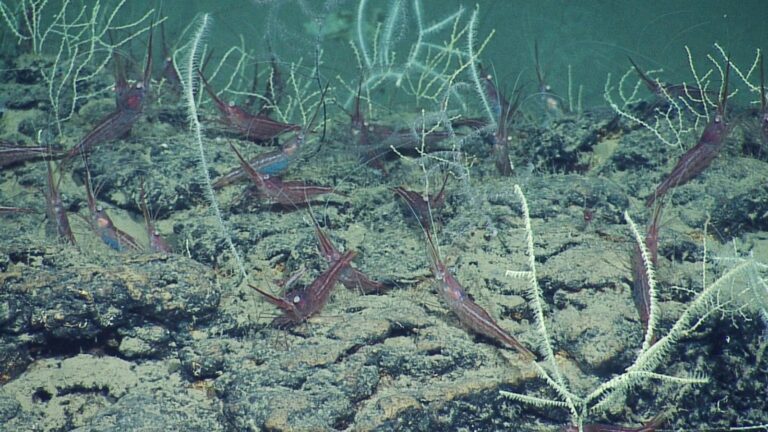When a team of Israeli marine researchers took off on a two and a half week voyage aboard the Exploration Vessel Nautilus, the robot-equipped research ship of Titanic discoverer Robert Ballard, they knew they were in for surprises, but they didn’t realize how big.
Thirty to 40 kilometers off the coast of Tel Aviv, in an area once thought to be relatively barren of sea life, the explorers discovered a huge reef of deep-sea coral stretching for several kilometers, some 700 meters under the sea.
Spread the Word
• Email this article to friends or colleagues
• Share this article on Facebook or Twitter
• Write about and link to this article on your blog
• Local relevancy? Send this article to your local press
“It’s like finding a flourishing oasis in the middle of the desert,” said Dr. Yizhaq Makovsky, who directed the University of Haifa control center for the project. “We did not expect, know, or even imagine that we would come across these reefs and certainly not such large ones.”
It’s a discovery that has broad scientific importance, and is just one of many discoveries the team of 11 Israeli experts from the University of Haifa’s School of Marine Sciences (CSMS), are beginning to make as they sift through the material they filmed during their voyage on the Nautilus, which ended on September 14.

Shipwrecks and ghost sharks
Sending the ship’s robots down as far as 1.7 kilometers into the Mediterranean they discovered underwater landslide scars, deep-sea corals, ancient archaeological artifacts, gas seeps, submarine canyons, exotic creatures, and even a couple of shipwrecks – probably modern boats that sank over the past few decades.
Researchers say one of the most fascinating fish captured by the ship’s cameras was the Chimera Monstrosa, a member of the “ghost sharks” family that branched off from sharks some 400 million years ago.
The crew used sonar to scan the ocean floor and identify targets to explore further. Then they lowered a robotic device dubbed Argus, out of which emerged another robot, Hercules, whose job it is to gather samples.
At the helm of the expedition was Ballard’s longtime marine geophysics colleague, Israel Prize winner Prof. Zvi Ben-Avraham, founding director of Haifa University’s School of Marine Sciences. He and a cadre of faculty and graduate students joined the existing Nautilus crew as part of the pilot project for a planned multi-year cooperation program.
“It’s as if one morning I would call you and say, ‘Today you’re going for two weeks to Mars.’ What would you expect to find there?” Dr. Uri Schattner, incoming department head of marine geoscience at CSMS tells ISRAEL21c.
So much technology to see mud
The Israelis mapped out each stage of the journey before embarking, but because so little is known about the ocean floor, they did not have a clear idea of what they would find. “Our initial scientific plan was general, marking areas rather than specific targets,” Schattner relates.

“Israel should take responsibility for its maritime environment, resources and infrastructure. This environment extends across Israel’s exclusive economic zone over a region greater than half its land territory,” Schattner continues.
Thanks to the battery of high-definition cameras embedded in Hercules, nobody had to wait until the Nautilus docked to see the sediment, shells, coral, worm casings and water samples it brought back to the surface.
All the images were recorded on the ship and at the university, sent via satellite to the University of Rhode Island (where Ballard is a professor), and from there to the Nautilus website – so that anyone with an Internet connection could view what was happening with only a two-second delay. At the website, an interactive interface enabled real-time Q&A with the Nautilus educator.
“So much technology to see so many fish and seafloor mud,” quips Schattner. “It’s fun and exciting, and the best part is – it’s our daily work.”
Israeli schoolchildren, families and geography teachers joined scientists and students watching the undersea adventure live in the CSMS control center, with the added benefit of explanatory narration and lectures by CSMS faculty. In addition, a team of experts led by Makovsky held 24/7 shifts to help those on deck to identify what Hercules scavenged.
Better maps of distant planets than of the seafloor
“This unique collaboration gives expression to the central emphasis that the University of Haifa has decided to place on marine research, a resource that promises many discoveries in a variety of areas: Economy, medicine, energy, biology and more,” says university president Prof. Aaron Ben-Ze’ev. “The future is in the sea and this voyage is a first step toward understanding the mystery of a region that is so close to us yet still so far and unknown.”
The ongoing Nautilus ‘Mysteries of the Sea’ project is overseen by Ballard with funding from National Geographic and the US National Oceanic and Atmospheric Administration. Ballard, best known for his 1985 discovery of the Titanic shipwreck, has pointed out that better maps exist of distant planets than of the floor of the waters that make up 72 percent of planet Earth.
Over the course of 125 expeditions, Ballard has shed light on tens of thousands of active volcanoes, massive heavy metal deposits, hydrothermal vent systems, limestone sculptures, 10-foot-tall tubeworms, and ancient relics 12,000 feet underwater.
E/V Nautilus, a 210-foot vessel based in Turkey under the ownership of the Ocean Exploration Trust, goes out on different expeditions each year. CSMS scientists are now trying to raise funds for future joint cruises and to enhance the educational outreach aspect of the project.
The joy of discovery belongs to everyone
“Science enthusiasm and the joy of discovery belong to everyone,” says Schattner, who envisions a sponsored science competition for high school students next year. The lucky winners would be awarded the opportunity to conduct their science experiments under the deep sea, wherever the Nautilus may be.
Whether or not that comes to pass, the Nautilus opportunity enhanced the public profile of the marine sciences school, established three years ago to offer a unique holistic approach to ocean studies. The research and teaching at CSMS combine geosciences, biology, maritime and coastal archaeology and oceanography. Maritime law and policy are areas to be added to the mix.
The research mission has also given observers a “nutshell sampling” of what lies beneath the blue Mediterranean, said Makovsky, who is now calling for the area of the reefs to be classified as a deep-sea reserve. “Our discovery only demonstrates the potential of the many surprises that await us in the depths of this area,” he said.

















